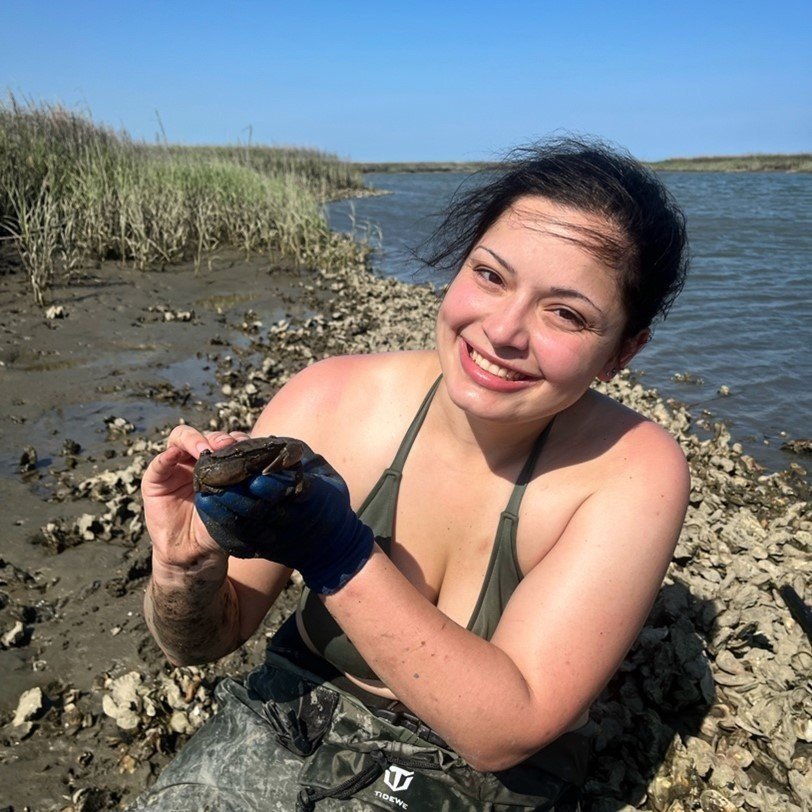
Madison Janakis
Department of Biological Sciences
University of South Carolina
Madison’s Story
Growing up on the coast of Maine, Madison spent her childhood on the beach catching critters and getting pinched by crabs. Her passion for marine biology was born: she’d seek a revenge on those crabs. After high school, to everyone’s surprise she moved to landlocked Chicago. (Take that, crabs!)
At DePaul University, Madison double majored in environmental science and biology. Between junior and senior year, Madison received a Dean’s Undergraduate Fellowship through DePaul at the Field Museum. Over the summer, she worked to sequence the photobiont component of Caribbean lichens. Her focus returned to marine biology in her senior year, where her undergraduate thesis investigated how oysters that experienced both acidic conditions and thermal stress would respond to a hypoxia event. The full results of this project never reached fruition due to COVID-19. Madison received her B.S. from DePaul in Spring of 2020 and promptly left Chicago.
Two weeks before the first lockdown, Madison was accepted into the Biological Sciences PhD program at the University of South Carolina. She moved to Columbia, SC and began in Dr. Daniel Speiser’s lab in fall semester 2020. Dr. Speiser’s lab is focused on visual ecology- something she was clueless on at the time (but now only partly clueless). Her project—through trial and error and a whole lot of reading—is now focused on the visual ecology of crabs from tidal pools. Somewhere along the way, she’s forgiven the little guys, as she now has a better idea of how they see the world and can (mostly) avoid being pinched.
Close-up of black-fingered mud crab (Panopeus herbstii)
(image by M. Janakis)
Madison’s Research
Green porcelain crab (Petrolisthes armatus) frontal view
(image by M. Janakis)
The crabs of Madison’s research are found in North Inlet, Winyah Bay, SC, at Baruch Marine Field Lab. The water within the inlet varies dramatically in color and clarity depending on a number of factors including weather, tide and season. These conditions lead to visually complex and dynamic visual environments. Her research focuses on comparing the visual ecology of crabs living in that ecosystem. Many questions fall under this umbrella: What colors are they sensitive to? How acute is their vision? Can they see polarized light? And many others.
The first chapter of Madison’s thesis is focused on comparing vision of two species of crab: green porcelain crabs (Petrolisthes armatus) and black-fingered mud crabs (Panopeus herbstii). The research mainly used behavior assays and electro-physiological techniques. The second chapter will investigate how crabs use their vision in predator avoidance, by using behavioral experiments alongside electrophysiology. Lastly, the third chapter is planned to focus on behavioral studies to analyze foraging behaviors.
Slocum Lunz Foundation is providing funds to purchase a new GoPro camera and aquarium light for recording all behavioral experiments. The camera has been crucial for her to extract information for data analysis. She is now able to score behavior while re-watching video, as well as using tracking software to gain more information. This raw footage will be preserved and used as needed in future research. The aquarium light also allows for performing behavioral assays under different light conditions (including brightness and color). Together, this equipment will continue to help Madison collect data for her final two chapters of her dissertation research.
Publications and Presentations associated with Slocum-Lunz Foundation funds:
Janakis, M., Speiser, D., 2023. Comparative visual ecology of two sympatric crabs from tidal creeks. Poster presented at Society for Integrative and Comparative Biology Annual Meeting, January 3-6, 2023, Austin, TX.



